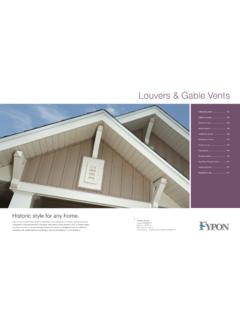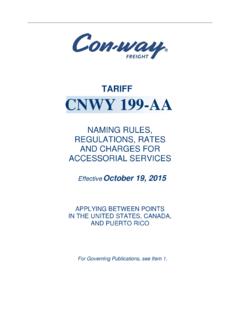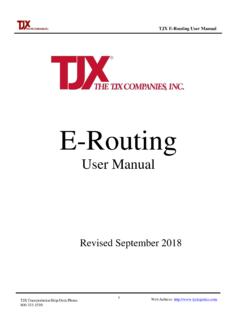Transcription of This document is an OVERVIEW ONLY To access the Full …
1 This document is an OVERVIEW ONLY. To access the Full Procedure: ISTA Members: Login to the MEMBER CENTER and choose the Resources Folder and then File Archive to download the full procedures. Non-Members: You may purchase the full procedure by visiting our STORE. Ships in Own Container (SIOC) for 2. Distribution System 0. 1. Shipment 8. ISTA 6 Series ISTA, Distributing Confidence, Worldwide . Member Performance ISTA 6-Series Member Performance Tests are protocols created by ISTA members to suit their own particular purposes and Test applications. This test was developed by ISTA in cooperation with , and is designed as a General Simulation protocol. General Simulation tests PROJECT*. Challenge the capability of the package and product to withstand transport hazards, but Utilize general simulation of actual transport hazards, and Do not necessarily comply with carrier packaging regulations. When properly executed, ISTA procedures will provide tangible benefits of: VERSION Product to market time reduction DATE Confidence in product launch Reduction in damage and product loss Balanced distribution costs Last Customer satisfaction contributing to increased market share TECHNICAL.
2 Change: There are three sections to this procedure: OVERVIEW , Testing, and Reporting March OVERVIEW provides general knowledge required before testing and 2018 Testing presents the specific instructions to do laboratory testing and Reporting indicates what data shall be recorded to submit a test report. Last Two systems of weights and measures are presented in ISTA test procedures: English system (Inch-Pound) or SI (Metric). EDITORIAL Inch-Pound units are shown first followed by the Metric units in parentheses; there may be exceptions in some tables Change: (when shown separately). MARCH Familiarity with the following units and symbols used in this document is required: 2018. For measuring English units and symbols Metric units and symbols Weight pounds (lb) kilograms (kg) or grams (gm). For complete Force pounds force (lbf) newtons (N). listing of Distance feet (ft) or inches (in) meters (m) or millimeters (mm). Procedure meters per second (m/sec) or Changes and Velocity inches per second (in/sec).
3 Millimeters per second (mm/sec). Version Dates go to Volume cubic inches (in3) cubic centimeters (cm3) or cubic meters (m3). Density pounds per cubic inch (lb/in3) kilograms per cubic meter (kg/m3). Temperature Fahrenheit ( F) Celsius ( C). Either system may be used as the unit of measure, but The units chosen shall be used consistently throughout the procedure. Units are typically converted to two significant figures and Not exact equivalents. VERY IMPORTANT: The entire document shall be read and understood before proceeding with a test. * Notes Regarding ISTA Projects and Procedures . ISTA is currently an ISTA Project , first released in October 2014. New ISTA test protocols are given the designation "Project" during their implementation phase. After a minimum one-year period and required evaluation, a "Project" will either be adopted as an established "Procedure", revised and kept as a "Project" for another period of time, or be dropped. Therefore, a Project is potentially subject to greater and more frequent revision than a Procedure.
4 ISTA members may use either Procedures or Projects for package certification. Comments regarding this Project and its use are encouraged and welcome. Please contact Most recent technical change(s) ISTA 2018 - Page 1 of 52. Most recent technical addition(s) 2018 International Safe Transit Association. All rights Reserved. 6-AMAZON OVERVIEW OF PROJECT PROJEC..COM-SIOC. T. Project is a general simulation test for Ships In Own Container (SIOC) packaged-products shipped through Amazon's distribution system to final customer destinations. This testing protocol has been developed by combining data from previous studies of transportation environments, relevant testing protocols, Amazon Fulfillment Center environment visual observations, and customer feedback. This test is for packaged-products shipped by Vendors to Fulfillment Centers and delivered to final customer destinations via Parcel or Less-Than-Truckload (LTL) outbound shipment methods. It challenges the capability of both package and product to withstand transport hazards normally encountered during handling and transportation.
5 Vendors with items intended to utilize Ships In Own Container (SIOC) are encouraged to use this test to understand the protective performance of their packaging. Project has been created by with help from industry experts in both the packaging and transportation industries. This test is currently in the Project phase (pilot stage) and will be improved upon if/where needed using feedback from industry experts and users of the test. It is requested that you share feedback and other data from any testing conducted using this test including number of tests conducted, failure/success rate, types of failures, test performance compared to real world comparison, and any other helpful data points. Please share your feedback with will share this data with ISTA in an effort to improve the effectiveness of the test protocol. Project is appropriate for eight (8) different types of packaged-products designated Types A through H below. The different types are a combination of four (4) packaged-product criteria: Outbound Shipment Method, Fulfillment Center Handling Method, Packaged-Product Weight, and Product Category.
6 See Definitions below for an explanation of packaged-product types and other terms used in this document . Packaged-Product Test Types Type A: o Shipment Method: Parcel Delivery of Individual Packaged-Products o Handling Method: Standard Handling Method o Weight & Dimensions: Less than 50 lb (23 kg) & Girth equal to or less than 165 ( m). Type B: o Shipment Method: Parcel Delivery of Individual Packaged-Products o Handling Method: Standard Handling Method o Weight & Dimensions: 50 lb (23 kg) to Less than 100 lb (45 kg) & Girth equal to or less than 165 ( m). Type C: o Shipment Method: Parcel Delivery of Individual Packaged-Products o Handling Method: Standard Handling Method o Weight & Dimensions: 100 lb (45 kg) or Greater & Girth equal to or less than 165 ( m). Type D: o Shipment Method: Less-Than-Truckload (LTL) Delivery of Individual Packaged-Products o Handling Method: Standard Handling Method o Weight & Dimensions: Less than 100 lb (45 kg) or Girth greater than 165'' ( m). Type E: o Shipment Method: Less-Than-Truckload (LTL) Delivery of Individual Packaged-Products o Handling Method: Standard Handling Method o Weight & Dimensions: 100 lb (45 kg) or Greater or Girth greater than 165'' ( m).
7 Type F: o Shipment Method: Less-Than-Truckload (LTL) Delivery of Individual Packaged-Products o Handling Method: Pallet Handling Method o Weight & Dimensions: N/A & N/A. Type G: TV/Monitor o Product Category: TV/Monitor o Shipment Method: Parcel Delivery of Individual Packaged-Products O o Handling Method: Standard Handling Method o Weight & Dimensions: Less than 150 lb (68 kg) & Girth equal to or less than 165'' ( m). Type H: TV/Monitor o Product Category: TV/Monitor o Shipment Method: Less-Than-Truckload (LTL) Delivery of Individual Packaged-Products o Handling Method: Standard Handling Method o Weight & Dimensions: 150 lb (68 kg) or Greater or Girth greater than 165'' ( m). Most recent technical change(s) ISTA 2018 - Page 2 of 52. Most recent technical addition(s) 2018 International Safe Transit Association. All rights Reserved. 6-AMAZON OVERVIEW OF PROJECT PROJEC..COM-SIOC. Packaged-Product Criteria T Preface Outbound Shipment Method: o Parcel Delivery of Individual Packaged-Products (continued) o Less-Than-Truckload (LTL) Delivery of Individual Packaged-Products Packaged-Product Weight Greater than 150 lb or Any Packaged-Product Dimension Greater than 108 inches or Packaged-Product Girth Greater than 165 inches ( m) (Girth = Length + 2 * (Width + Height)) or Palletized Packaged-Product or Special Delivery Requirement by Amazon Fulfillment Center (FC) Handling Method: o Standard Handling Method (Floor Loaded) Individual packaged-products that are received at Fulfillment Center with no pallet or with multiple packaged products on a single pallet and are intended to ship to the end consumer without a pallet.
8 O Pallet Handling Method - Individual packaged-products that are received at Fulfillment Center on its own individual pallet and is intended to ship to the end consumer on a pallet. Weight of Packaged-Product: o Less than 50 lb (23 kg). o 50 lb (23 kg) to Less than 100 lb (45 kg). o 100 lb (45 kg) or Greater Product Category: o TV/Monitor - Any package which contains as a primary product a TV or a Monitor. This product category has been identified due to unique product attributes and inherent areas of fragility, in combination with distinct handling practices. Definitions Parcel Delivery. o Any individual packaged-product shipped by to the consumer via a Parcel delivery system such as UPS, FedEx, etc. (including elongated and flat packaged-product). Less than Truckload (LTL) Standard Packaged-Product o Any packaged-product shipped by to the consumer via an LTL delivery system (including elongated and flat packaged-product) that is not palletized or skidded Less than Truckload (LTL) Palletized Packaged-Product o Any packaged-product shipped by to the consumer via an LTL delivery system (including elongated and flat packaged-product) that is individually palletized or skidded Standard and Custom Pallet.
9 A standard pallet is a design which is in wide industry use, with published specifications, quality, and applications, used within those specifications and in a typical application. Standard pallets have information, provided by their manufacturers or distributors, available on the internet. A custom pallet is one designed for a specific product or narrow range of products, and with its design and performance characteristics not widely known or published. Elongated Packaged-Product o A packaged-product where the longest dimension is 36 in (910 mm) or greater and o both of the other dimensions are each 20 percent or less of the longest dimension Flat Packaged-Product o A packaged-product where the shortest dimension is 8 in (200 mm) or less and o the next longest dimension is four (4) or more times larger than the shortest dimension, and o the volume is 800 in3 (13,000 cm3) or greater NOTE: If a packaged-product is both Elongated and Flat in accordance with the above definitions, it should be tested as Elongated.
10 Non-Rigid Containers are defined as having one or more of the following characteristics: o the outer package may offer insufficient protection from concentrated low-level impacts or o the design has large unsupported spans of outer packaging material or o the outer package utilizes a stretch- or shrink-wrap design, a thin-flute or light grade corrugated board, a paper wrap or similar lightweight material only, etc. or o the outer package wall is in direct contact with the product TV/Monitor o Any packaged-product which contains a TV or Monitor regardless of packaging type, dimensions or weight. NOTE: If a packaged-product is defined as both Flat and TV/Monitor or both as Standard and TV/Monitor, in accordance with the above definitions, it should be tested as TV/Monitor. Most recent technical change(s) ISTA 2018 - Page 3 of 52. Most recent technical addition(s) 2018 International Safe Transit Association. All rights Reserved. 6-AMAZON OVERVIEW OF PROJECT PROJEC..COM-SIOC. Preface T(continued).








